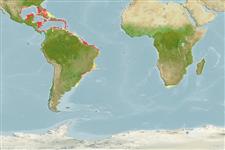Cladocora arbuscula (Lesueur, 1821)
Tube coral| Native range | All suitable habitat | Point map | Year 2050 |

|
| This map was computer-generated and has not yet been reviewed. |
| Cladocora arbuscula AquaMaps Data sources: GBIF OBIS |
Upload your photos
Google image |
No photo available for this species.No drawings available for Cladocoridae.
Google image |
No photo available for this species.
Classification / Names Common names | Synonyms | CoL | ITIS | WoRMS
Hexacorallia | Scleractinia | Cladocoridae
Environment: milieu / climate zone / depth range / distribution range Ekologi
Revassocierade; djupintervall 0 - 37 m (Ref. 78567). Tropical; 29°N - 36°S, 98°W - 32°E (Ref. 848)
Utbredning Länder | FAO områden | Ekosystem | Förekomster | Utplanteringar
Western Central Atlantic and Indo-Pacific.
Length at first maturity / Size / Vikt / Age
Maturity: Lm ? range ? - ? cm
Short description Morfologi
Formation: clumps of interlocking tubular corallites less than 4 mm in diameter; clumps either compact and attached to hard substrates, or loose aggregations on soft substrate that break when disturbed. Only the terminal parts of corallites are often alive. Thin and delicate septo-costae in 2 alternating orders, with irregular teeth. Corallite walls also thin and delicate. Color: tan or brown; tentacles translucent (Ref. 848).
Minimum depth (0-30 m) from Ref. 848. Maximum depth recorded from Simon's Bay, Cape of Good Hope at 10-20 fathoms. A dead fragment was obtained off Bermuda at 435 fathoms but species probably doesn't live at this depth (Ref. 78567).
Life cycle and mating behavior Könsmognad | Reproduktion | Lek | Ägg | Fecundity | Larver
Members of the class Anthozoa are either gonochoric or hermaphroditic. Mature gametes are shed into the coelenteron and spawned through the mouth. Life cycle: The zygote develops into a planktonic planula larva. Metamorphosis begins with early morphogenesis of tentacles, septa and pharynx before larval settlement on the aboral end.
Main reference
referenser | Koordinator | Medarbetare
Cairns, S.D., D.R. Calder, A. Brinckmann-Voss, C.B. Castro, D.G. Fautin, P.R. Pugh, C.E. Mills, W.C. Jaap, M.N. Arai, S.H.D. Haddock and D.M. Opresko. 2003. (Ref. 1663)
IUCN Red List Status (Ref. 130435: Version 2024-1)
Least Concern (LC) ; Date assessed: 01 June 2021
CITES status (Ref. 108899)
Appendix II: International trade monitored
CMS (Ref. 116361)
Not Evaluated
Threat to humans
Human uses
| FishSource |
Verktyg
Ytterligare information
Trophic Ecology
Ecology
Population dynamics
Tillväxt
Age/Size
Length-weight
Length-length
Length-frequencies
Mass conversion
Rekrytering
Abundans
Age/Size
Length-weight
Length-length
Length-frequencies
Mass conversion
Rekrytering
Abundans
Life cycle
Distribution
Human Related
Vattenbruksprofil
Stamps, Coins Misc.
Stamps, Coins Misc.
Outreach
References
Internet-källor
BHL | BOLD Systems | CISTI | DiscoverLife | FAO(Publication : search) | Fishipedia | GenBank (genome, nucleotide) | GloBI | Gomexsi | Google Books | Google Scholar | Google | PubMed | Tree of Life | Wikipedia (Go, sök) | Zoological Record
Estimates based on models
Preferred temperature
(Ref. 115969): 23.6 - 28.2, mean 27.3 (based on 609 cells).
Price category
(Ref. 80766):
Unknown.


